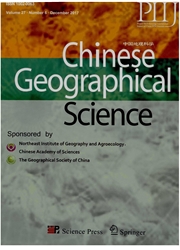

 中文摘要:
中文摘要:
支持的活跃旅行行为和减少的运输相关的二氧化碳(公司 2) 排出物在经历的许多中国城市里成为了优先级快速城市散漫并且更大的汽车依赖。然而,有很少研究,整体地检验与旅行公司 2 排出物联系的物理、社会的因素。用在沈阳进行的 1525 个顾客的调查,中国,这研究估计了购物相关的旅行公司 2 排出物并且检验了开发环境和单个社会经济的特征怎么贡献逛旅行行为和联系公司 2 排出物。我们比平均用公共运输逛旅行发现第一,私人汽车旅行产生更多的碳排出物将近八次。第二,每旅行有有公司 2 排出物的重要空间自相关,并且最高的碳排出物在内部郊区并且在第一和第二条环绕的道路之间被聚类。第三,每旅行逛旅行公司 2 排出物否定地包括人口密度,公共运输车站的数量,道路密度,和商店密度与几个开发环境特征被相关。他们也被发现是显著地,与汽车的单个社会经济的特征有关,所有权,雇用地位,和教育铺平使用一个多项的逻辑回归模型。这些实验调查结果有重要政策含意,在贡献城市的交通和会碳缓解的可持续性的措施的发展帮助指向。
 英文摘要:
英文摘要:
Promoting active travel behavior and decreasing transport-related carbon dioxide (CO2) emissions have become a priority in many Chinese cities experiencing rapid urban sprawl and greater automobile dependence. However, there are few studies that holistically examine the physical and social factors associated with travel CO2 emissions. Using a survey of 1525 shoppers conducted in Shenyang, China, this study estimated shopping-related travel CO2 emissions and examined how the built environment and individual socioeconomic characteristics contribute to shopping travel behavior and associated C02 emissions. We found that, firstly, private car trips generate nearly eight times more carbon emissions than shopping trips using public transport, on average. Second, there was sig- nificant spatial autocorrelation with CO2 emissions per trip, and the highest carbon emissions were clustered in the inner suburbs and between the first and second circumferential roads. Third, shopping travel CO2 emissions per trip were negatively correlated with sev- eral built environment features including population density, the quantity of public transport stations, road density, and shop density. They were also found to be significantly related to the individual socio-eeonomic characteristics of car ownership, employment status, and education level using a multinomial logistic regression model. These empirical findings have important policy implications, assisting in the development of measures that contribute to the sustainability of urban transportation and meet carbon mitigation targets.
 同期刊论文项目
同期刊论文项目
 同项目期刊论文
同项目期刊论文
 Examining the relationships between land cover and greenhouse gas concentrations using remote - sens
Examining the relationships between land cover and greenhouse gas concentrations using remote - sens 期刊信息
期刊信息
